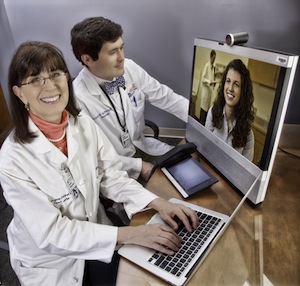
At a Glance
- UVA Telestroke Program is celebrating its 1,000th patient encounter
- The UVA telestroke team is available 24/7
- Through the UVA Telestroke Program, community hospitals can provide rapid access to comprehensive stroke services
- The UVA program offers advantages over for-profit telestroke services
Just in time for National Stroke Month, the UVA Telestroke Program is celebrating its 1,000th patient encounter. Since 2010, the program has facilitated approximately 35 to 40 remote consults each month among its six partner hospitals.
Augusta Health is one of the “spoke” hospitals that has been offering telestroke services to its patients since 2015. “This has been a very successful program for us,” says Augusta Health ED Medical Director Adam Rochman, MD. “We can now offer patients in our community services that you typically can’t receive at a smaller community hospital.”
Rochman adds that, historically, patients were only evaluated for endovascular stroke treatment if they went to an academic medical center for emergency stroke care. “But through the UVA Telestroke Program, we can rapidly evaluate which patients are candidates and refer them so that they get treated quickly. It’s been an excellent arrangement for both centers,” he says
Telehealth, the use of digital information and communication technologies to provide remote medical care, is a service now available in almost every specialty as part of the UVA Karen S. Rheuban Center for Telehealth. However, what is unique about telestroke is the emergent aspect of acute stroke care, according to UVA neurologist Nina Solenski, MD. “There is no down time for our team or our equipment because that could mean minutes lost for the patient — and when it comes to stroke, those minutes matter,” she says.
Equipment used by the telestroke program must remain at the ready at all times, which requires the expertise of specially trained technicians and engineers. “They are amazing; they take calls with us at all hours,” says Solenski. “The patient and partner providers may only see the faces on the screen, but telestroke is a team effort and there are many of us.”
In addition to technicians, specially trained stroke care nurses and others, there are seven providers who make up the Telestroke Program at UVA, including board-certified stroke neurologists, interventional neuroradiologists, neurosurgeons and neurointensivists. On call 24/7, this team may do stroke consults from their offices, homes or on the road, if necessary.
“As long as you have a HIPAA-compliant connection, you can do a consult just about anywhere because the technology is portable,” says Solenski. “It’s videoconferencing on steroids.”
No matter where they are, with every encounter, Solenski says: “The goal is to provide the exact same care via telestroke as a patient would receive walking through the doors of UVA Medical Center.”
It is this commitment to quality care, as well as the resources UVA provides as a Comprehensive Stroke Center, that makes UVA a top pick among hospitals throughout the Commonwealth and beyond who wish to expand their stroke services. Community hospitals interested in telestroke services have a choice of providers, including some that are for-profit, says Solenski. However, she believes her team offers something other providers cannot.
“We have a different relationship with our partner hospitals,” says Solenski. “We have a rapport with ED teams because they see the same physicians every time they contact us. And I personally visit our partner sites to ensure good two-way feedback.”
How Can UVA Telestroke Program Support Your Community Hospital?
A partnership with the UVA Telestroke program provides community hospitals and patients with enhanced, cost-efficient care by:
- Providing urgent medical assessments to determine the likelihood and severity of a stroke and the best course of treatment, with access to evidence-based treatments, including IV thrombolytics and innovative clot retrieval procedures;
- Facilitating bed transfers to the UVA Neuro ICU and Stroke Unit for acute stroke patients when needed and providing ongoing neurologic consultation when transfer is not necessary;
- Communicating directly with the patient and their family once the patient is stabilized by explaining the clinical evaluation, treatment options and prognosis and allowing ample time to answer questions and address concerns, reducing the burden on the community hospital staff;
- Providing specialized online and on-site training to help providers and their patients quickly recognize the signs and symptoms of stroke, saving valuable time.
To find out how your organization can partner with the UVA Telestroke Program, contact Dr. Solenski by email or call 800.552.3723.